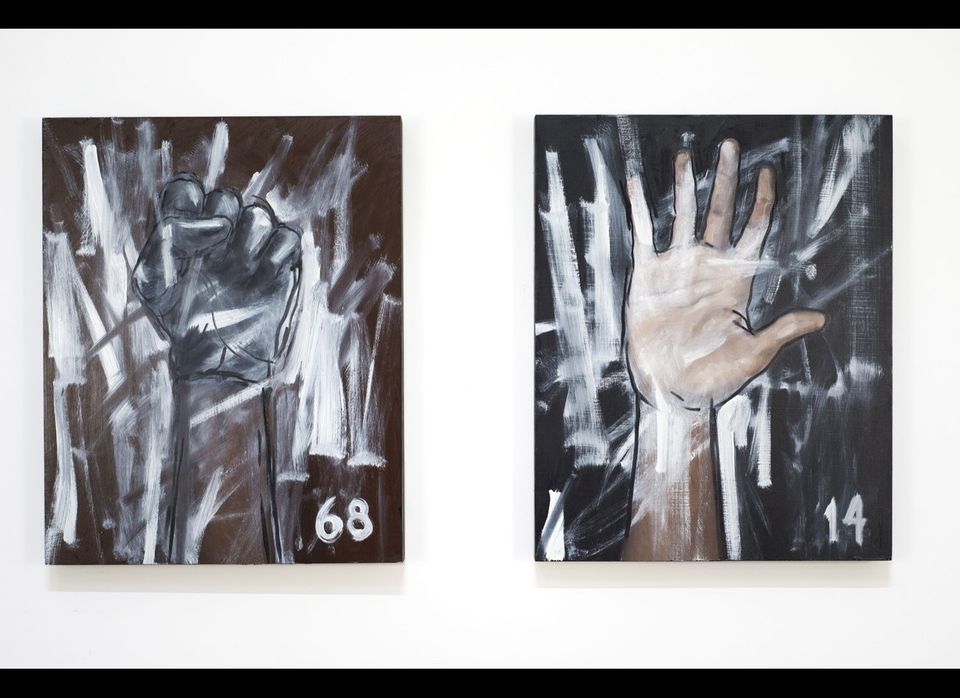While visiting Titus Kaphar's exhibition Asphalt and Chalk at Jack Shainman Gallery in Chelsea, New York in early February, I was struck by the power, simplicity and deceptive ordinariness of two small panels, a diptych, near the entrance. On one panel a raised clenched fist, realistically rendered, has been all but obliterated by what appear to be rapidly applied expressionist strokes of white paint; on the other an open palm has been given a similar whiteout treatment.
Both hands are black, and written in white paint at the bottom-right of the respective panels are the numbers "68" and "14." This piece, painted last year, is cryptically titled 1968/2014. The exhibition features other larger paintings, such as Another Fight For Remembrance (2014), showing crowded scenes of black figures with hands raised and open against a dark night sky, their faces partially visible, obscured by the riot of glowing white paint. In all, these works give the impression of a struggle between an inchoate yet assertive whiteness bent on erasing the thoughtfully rendered, gesturing black bodies.
Although these paintings rehearse the painterly tactics we have come to associate with Kaphar's pictorial archaeology of Euro-American art history and racial experience, they speak more directly to recent events in the United States, specifically the fatal shooting by police of the unarmed black youth from Ferguson, Missouri, Michael Brown, on August 9, 2014. To be sure, Brown's death at the hands of the police marks only one of several such incidents that occur with alarming frequency; but it touched an already raw nerve and set off mass demonstrations -- and, unfortunately, the occasional riot -- such as the streets of America have not seen since the Los Angeles Riots of 1992, following the acquittal of policemen caught on tape beating another black man, Rodney King.
Kaphar's 1968/2014 and other paintings, commissioned by Time magazine in the wake of the Ferguson riots, are however not simply visual meditations on the Ferguson incident; rather they memorialize the radical public testifying to the reality and history of brutalization, especially of the black male, by state security agents and a reawakening of mass resistance to systemic oppression of blacks in America, despite the supposed gains of the civil rights movement and the now wishful arrival -- after the election of President Barack Obama in 2008 -- of a postracial dawn. In depicting the fist and the open palm, the diptych, in other words, imagines the 2014 rallies in Ferguson and elsewhere around the United States, along with the passive die-ins in streets and college campuses and the social media phenomenon #BlackLivesMatter, as a contemporary reincarnation not only of the passive resistance of the mainstream civil rights movement, but also the radical politics of the Black Power Movement (BPM) of the 1960s.
Whereas the iconic symbol of the BPM was the black clenched fist, ever ready to deploy the same coercive violence the state claims as its prerogative, the open palm of Ferguson -- whatever the truth is of the incident that led to Brown's death -- signifies present-day recognition that the oppressed, utterly at the mercy of state power, can still mobilize the force of collective moral outrage to wrest whatever rights and concessions they can from an insensitive and unjust system. Thus the juxtaposition of the two iconic hand gestures suggests a historical, and perhaps even ideological, connection between the events with which both are associated.
However, the underlying premise of this work, as I understand it -- that the 1960s dream for a more just society in which the color of one's skin ceases to determine one's fate and opportunities remains a dream deferred -- raises an important question to contemporary art and artists: why the resounding silence in the face of the turmoil outside? Is not the art world, which has as never before become captive of big money, living the great denial originally perpetuated by postwar New York modernism; that aesthetics had nothing to do with ethics, and that art invents and inhabits its own safe world unconnected to the socio-political infrastructures and ethical imperatives with which individual and collective life contends?
If, as Kaphar's diptych suggests -- and as recent commentators have noted -- Ferguson and the movement it catalyzed announce a new civil rights era, we have to ask, with an eye to history: When will contemporary artists acknowledge through their work, words and actions that something profound, is happening in our streets? Perhaps after the art fairs.

